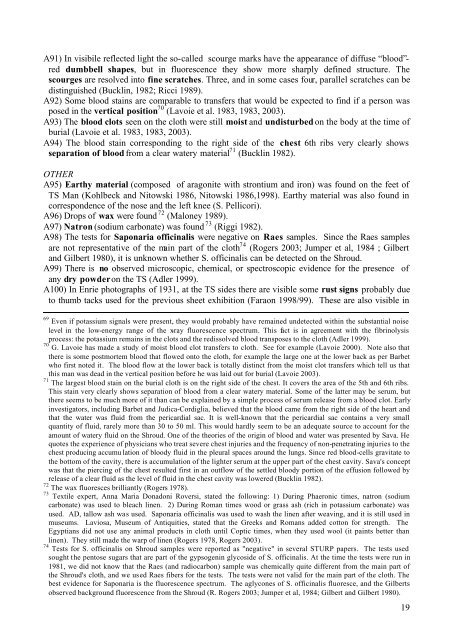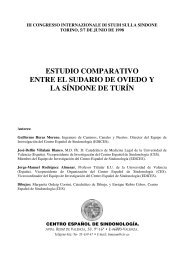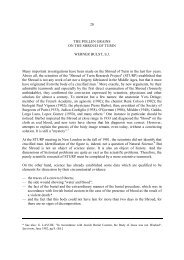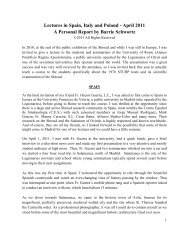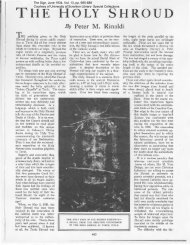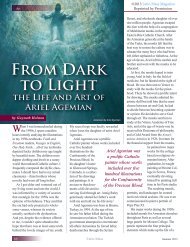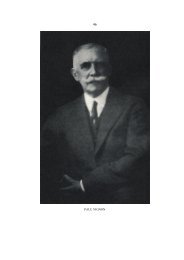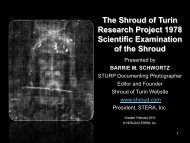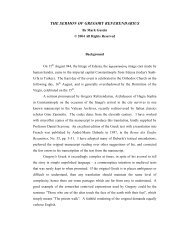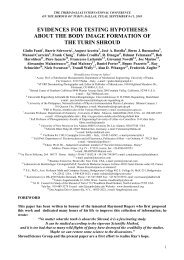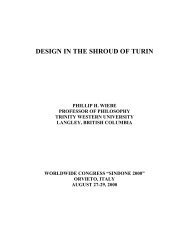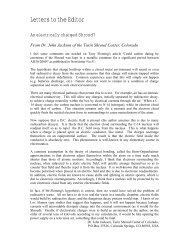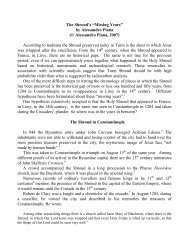list of evidences 10d Barrie - The Shroud of Turin Website
list of evidences 10d Barrie - The Shroud of Turin Website
list of evidences 10d Barrie - The Shroud of Turin Website
Create successful ePaper yourself
Turn your PDF publications into a flip-book with our unique Google optimized e-Paper software.
A91) In visibile reflected light the so-called scourge marks have the appearance <strong>of</strong> diffuse “blood”-red dumbbell shapes, but in fluorescence they show more sharply defined structure. <strong>The</strong>scourges are resolved into fine scratches. Three, and in some cases four, parallel scratches can bedistinguished (Bucklin, 1982; Ricci 1989).A92) Some blood stains are comparable to transfers that would be expected to find if a person wasposed in the vertical position 70 (Lavoie et al. 1983, 1983, 2003).A93) <strong>The</strong> blood clots seen on the cloth were still moist and undisturbed on the body at the time <strong>of</strong>burial (Lavoie et al. 1983, 1983, 2003).A94) <strong>The</strong> blood stain corresponding to the right side <strong>of</strong> the chest 6th ribs very clearly showsseparation <strong>of</strong> blood from a clear watery material 71 (Bucklin 1982).OTHERA95) Earthy material (composed <strong>of</strong> aragonite with strontium and iron) was found on the feet <strong>of</strong>TS Man (Kohlbeck and Nitowski 1986, Nitowski 1986,1998). Earthy material was also found incorrespondence <strong>of</strong> the nose and the left knee (S. Pellicori).A96) Drops <strong>of</strong> wax were found 72 (Maloney 1989).A97) Natron (sodium carbonate) was found 73 (Riggi 1982).A98) <strong>The</strong> tests for Saponaria <strong>of</strong>ficinalis were negative on Raes samples. Since the Raes samplesare not representative <strong>of</strong> the main part <strong>of</strong> the cloth 74 (Rogers 2003; Jumper et al, 1984 ; Gilbertand Gilbert 1980), it is unknown whether S. <strong>of</strong>ficinalis can be detected on the <strong>Shroud</strong>.A99) <strong>The</strong>re is no observed microscopic, chemical, or spectroscopic evidence for the presence <strong>of</strong>any dry powder on the TS (Adler 1999).A100) In Enrie photographs <strong>of</strong> 1931, at the TS sides there are visible some rust signs probably dueto thumb tacks used for the previous sheet exhibition (Faraon 1998/99). <strong>The</strong>se are also visible in69 Even if potassium signals were present, they would probably have remained undetected within the substantial noiselevel in the low-energy range <strong>of</strong> the x-ray fluorescence spectrum. This fact is in agreement with the fibrinolysisprocess: the potassium remains in the clots and the redissolved blood transposes to the cloth (Adler 1999).70 G. Lavoie has made a study <strong>of</strong> moist blood clot transfers to cloth. See for example (Lavoie 2000). Note also thatthere is some postmortem blood that flowed onto the cloth, for example the large one at the lower back as per Barbetwho first noted it. <strong>The</strong> blood flow at the lower back is totally distinct from the moist clot transfers which tell us thatthis man was dead in the vertical position before he was laid out for burial (Lavoie 2003).71 <strong>The</strong> largest blood stain on the burial cloth is on the right side <strong>of</strong> the chest. It covers the area <strong>of</strong> the 5th and 6th ribs.This stain very clearly shows separation <strong>of</strong> blood from a clear watery material. Some <strong>of</strong> the latter may be serum, butthere seems to be much more <strong>of</strong> it than can be explained by a simple process <strong>of</strong> serum release from a blood clot. Earlyinvestigators, including Barbet and Judica-Cordiglia, believed that the blood came from the right side <strong>of</strong> the heart andthat the water was fluid from the pericardial sac. It is well-known that the pericardial sac contains a very smallquantity <strong>of</strong> fluid, rarely more than 30 to 50 ml. This would hardly seem to be an adequate source to account for theamount <strong>of</strong> watery fluid on the <strong>Shroud</strong>. One <strong>of</strong> the theories <strong>of</strong> the origin <strong>of</strong> blood and water was presented by Sava. Hequotes the experience <strong>of</strong> physicians who treat severe chest injuries and the frequency <strong>of</strong> non-penetrating injuries to thechest producing accumu lation <strong>of</strong> bloody fluid in the pleural spaces around the lungs. Since red blood-cells gravitate tothe bottom <strong>of</strong> the cavity, there is accumulation <strong>of</strong> the lighter serum at the upper part <strong>of</strong> the chest cavity. Sava's conceptwas that the piercing <strong>of</strong> the chest resulted first in an outflow <strong>of</strong> the settled bloody portion <strong>of</strong> the effusion followed byrelease <strong>of</strong> a clear fluid as the level <strong>of</strong> fluid in the chest cavity was lowered (Bucklin 1982).72 <strong>The</strong> wax fluoresces brilliantly (Rogers 1978).73 Textile expert, Anna Maria Donadoni Roversi, stated the following: 1) During Phaeronic times, natron (sodiumcarbonate) was used to bleach linen. 2) During Roman times wood or grass ash (rich in potassium carbonate) wasused. AD, tallow ash was used. Saponaria <strong>of</strong>ficinalis was used to wash the linen after weaving, and it is still used inmuseums. Laviosa, Museum <strong>of</strong> Antiquities, stated that the Greeks and Romans added cotton for strength. <strong>The</strong>Egyptians did not use any animal products in cloth until Coptic times, when they used wool (it paints better thanlinen). <strong>The</strong>y still made the warp <strong>of</strong> linen (Rogers 1978, Rogers 2003).74 Tests for S. <strong>of</strong>ficinalis on <strong>Shroud</strong> samples were reported as "negative" in several STURP papers. <strong>The</strong> tests usedsought the pentose sugars that are part <strong>of</strong> the gypsogenin glycoside <strong>of</strong> S. <strong>of</strong>ficinalis. At the time the tests were run in1981, we did not know that the Raes (and radiocarbon) sample was chemically quite different from the main part <strong>of</strong>the <strong>Shroud</strong>'s cloth, and we used Raes fibers for the tests. <strong>The</strong> tests were not valid for the main part <strong>of</strong> the cloth. <strong>The</strong>best evidence for Saponaria is the fluorescence spectrum. <strong>The</strong> aglycones <strong>of</strong> S. <strong>of</strong>ficinalis fluoresce, and the Gilbertsobserved background fluorescence from the <strong>Shroud</strong> (R. Rogers 2003; Jumper et al, 1984; Gilbert and Gilbert 1980).19


